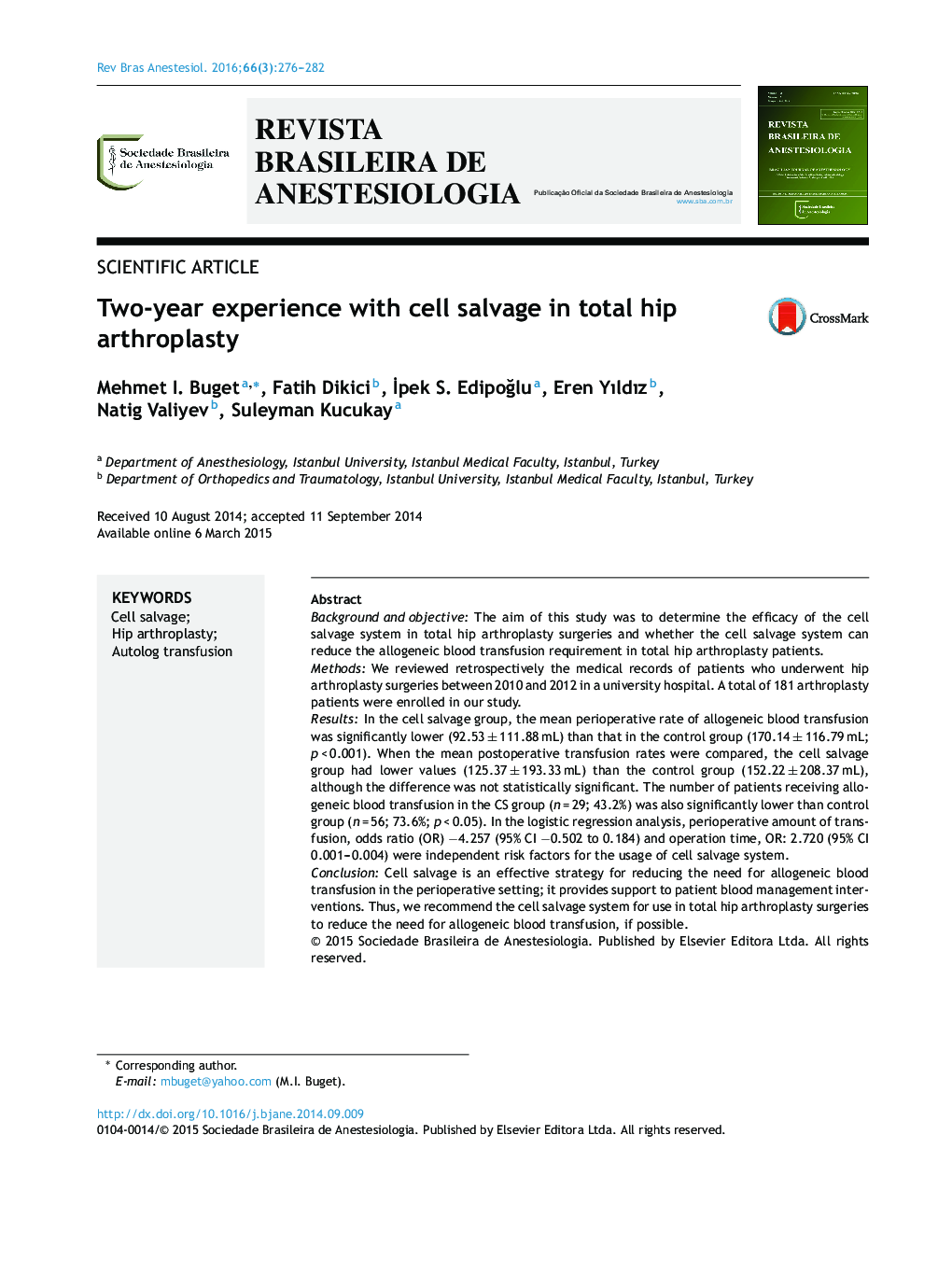| کد مقاله | کد نشریه | سال انتشار | مقاله انگلیسی | نسخه تمام متن |
|---|---|---|---|---|
| 2750171 | 1567298 | 2016 | 7 صفحه PDF | دانلود رایگان |
Background and objectiveThe aim of this study was to determine the efficacy of the cell salvage system in total hip arthroplasty surgeries and whether the cell salvage system can reduce the allogeneic blood transfusion requirement in total hip arthroplasty patients.MethodsWe reviewed retrospectively the medical records of patients who underwent hip arthroplasty surgeries between 2010 and 2012 in a university hospital. A total of 181 arthroplasty patients were enrolled in our study.ResultsIn the cell salvage group, the mean perioperative rate of allogeneic blood transfusion was significantly lower (92.53 ± 111.88 mL) than that in the control group (170.14 ± 116.79 mL; p < 0.001). When the mean postoperative transfusion rates were compared, the cell salvage group had lower values (125.37 ± 193.33 mL) than the control group (152.22 ± 208.37 mL), although the difference was not statistically significant. The number of patients receiving allogeneic blood transfusion in the CS group (n = 29; 43.2%) was also significantly lower than control group (n = 56; 73.6%; p < 0.05). In the logistic regression analysis, perioperative amount of transfusion, odds ratio (OR) −4.257 (95% CI −0.502 to 0.184) and operation time, OR: 2.720 (95% CI 0.001–0.004) were independent risk factors for the usage of cell salvage system.ConclusionCell salvage is an effective strategy for reducing the need for allogeneic blood transfusion in the perioperative setting; it provides support to patient blood management interventions. Thus, we recommend the cell salvage system for use in total hip arthroplasty surgeries to reduce the need for allogeneic blood transfusion, if possible.
ResumoJustificativa e objetivoO objetivo deste estudo foi determinar a eficácia do sistema de resgate celular em artroplastia total de quadril e se o sistema de recuperação intraoperatória de sangue pode reduzir a necessidade de transfusão de sangue alogênico em pacientes submetidos à artroplastia total de quadril.MétodosAnálise retrospectiva dos prontuários de pacientes submetidos a cirurgias de artroplastia de quadril entre 2010 e 2012 em um hospital universitário. No total, 181 pacientes submetidos à artroplastia foram inscritos no estudo.ResultadosA média da taxa de transfusão de sangue alogênico no período perioperatório foi significativamente inferior no grupo de recuperação intraoperatória de sangue (92,53 ± 111,88 mL) que no grupo controle (170,14 ± 116,79 mL; p < 0,001). Quando as médias das taxas de transfusão no pós-operatório foram comparadas, o grupo de recuperação intraoperatória de sangue apresentou valores inferiores (125,37 ± 193,33 mL) aos do grupo controle (152,22 ± 208,37 mL), embora a diferença não tenha sido estatisticamente significativa. O número de pacientes que recebeu transfusão de sangue alogênico no grupo RC (n = 29; 43,2%) também foi significativamente inferior ao do grupo controle (n = 56; 73,6%; p < 0,05). Na análise de regressão logística, a quantidade de transfusão no período perioperatório, a razão de chance (OR) –4,257 (95% CI –0,502–0,184) e o tempo cirúrgico, OR: 2,720 (IC 95% 0,001-0,004) foram fatores de risco independentes para o uso de sistema de resgate celular.ConclusãoA recuperação intraoperatória de sangue é uma estratégia eficaz para reduzir a necessidade de transfusão de sangue alogênico no período perioperatório, que auxilia no manejo sanguíneo durante as intervenções. Portanto, recomendamos o sistema de recuperação intraoperatória de sangue para uso em artroplastia total de quadril para diminuir a necessidade de transfusão de sangue alogênico, quando possível.
Journal: Brazilian Journal of Anesthesiology (English Edition) - Volume 66, Issue 3, May–June 2016, Pages 276–282
